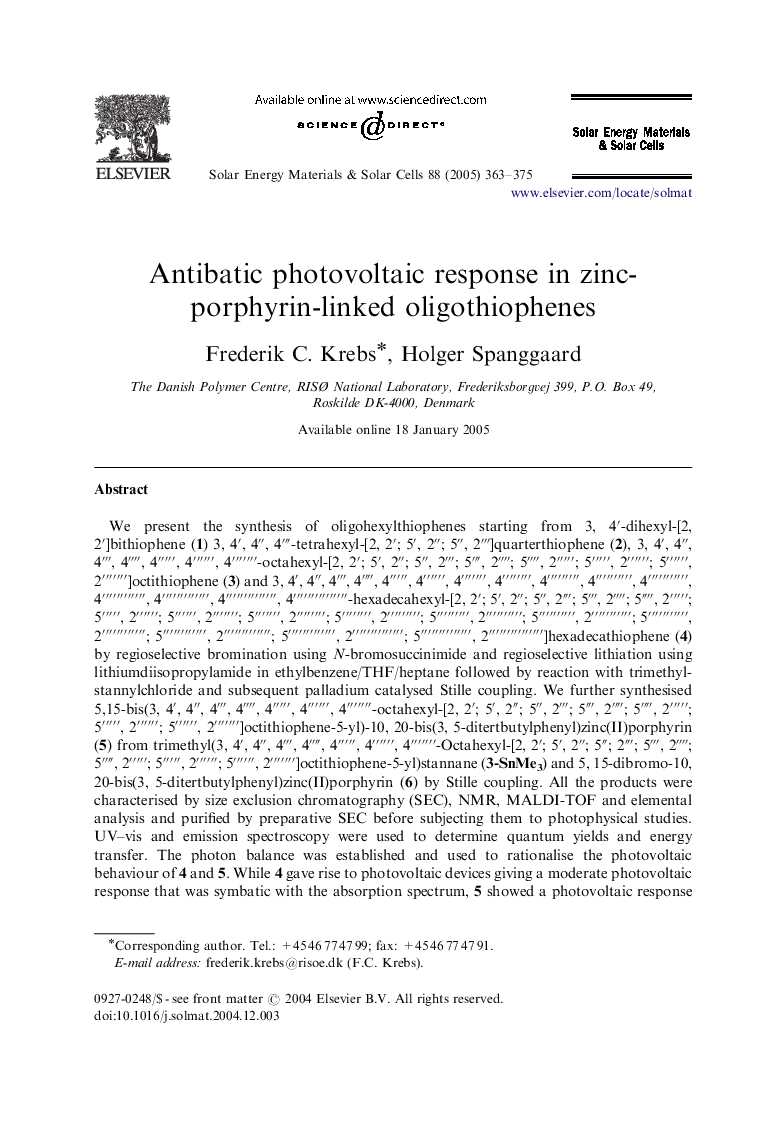| Article ID | Journal | Published Year | Pages | File Type |
|---|---|---|---|---|
| 10249135 | Solar Energy Materials and Solar Cells | 2005 | 13 Pages |
Abstract
We present the synthesis of oligohexylthiophenes starting from 3, 4â²-dihexyl-[2, 2â²]bithiophene (1) 3, 4â², 4â³, 4â´-tetrahexyl-[2, 2â²; 5â², 2â³; 5â³, 2â´]quarterthiophene (2), 3, 4â², 4â³, 4â´, 4â, 4â²â²â²â²â², 4â²â²â²â²â²â², 4â²â²â²â²â²â²â²-octahexyl-[2, 2â²; 5â², 2â³; 5â³, 2â´; 5â´, 2â; 5â, 2â²â²â²â²â²; 5â²â²â²â²â², 2â²â²â²â²â²â²; 5â²â²â²â²â²â², 2â²â²â²â²â²â²â²]octithiophene (3) and 3, 4â², 4â³, 4â´, 4â, 4â²â²â²â²â², 4â²â²â²â²â²â², 4â²â²â²â²â²â²â², 4â²â²â²â²â²â²â²â², 4â²â²â²â²â²â²â²â²â², 4â²â²â²â²â²â²â²â²â²â², 4â²â²â²â²â²â²â²â²â²â²â², 4â²â²â²â²â²â²â²â²â²â²â²â², 4â²â²â²â²â²â²â²â²â²â²â²â²â², 4â²â²â²â²â²â²â²â²â²â²â²â²â²â², 4â²â²â²â²â²â²â²â²â²â²â²â²â²â²â²-hexadecahexyl-[2, 2â²; 5â², 2â³; 5â³, 2â´; 5â´, 2â; 5â, 2â²â²â²â²â²; 5â²â²â²â²â², 2â²â²â²â²â²â²; 5â²â²â²â²â²â², 2â²â²â²â²â²â²â²; 5â²â²â²â²â²â²â², 2â²â²â²â²â²â²â²â²; 5â²â²â²â²â²â²â²â², 2â²â²â²â²â²â²â²â²â²; 5â²â²â²â²â²â²â²â²â², 2â²â²â²â²â²â²â²â²â²â²; 5â²â²â²â²â²â²â²â²â²â², 2â²â²â²â²â²â²â²â²â²â²â²; 5â²â²â²â²â²â²â²â²â²â²â², 2â²â²â²â²â²â²â²â²â²â²â²â²; 5â²â²â²â²â²â²â²â²â²â²â²â², 2â²â²â²â²â²â²â²â²â²â²â²â²â²; 5â²â²â²â²â²â²â²â²â²â²â²â²â², 2â²â²â²â²â²â²â²â²â²â²â²â²â²â²; 5â²â²â²â²â²â²â²â²â²â²â²â²â²â², 2â²â²â²â²â²â²â²â²â²â²â²â²â²â²â²]hexadecathiophene (4) by regioselective bromination using N-bromosuccinimide and regioselective lithiation using lithiumdiisopropylamide in ethylbenzene/THF/heptane followed by reaction with trimethylstannylchloride and subsequent palladium catalysed Stille coupling. We further synthesised 5,15-bis(3, 4â², 4â³, 4â´, 4â, 4â²â²â²â²â², 4â²â²â²â²â²â², 4â²â²â²â²â²â²â²-octahexyl-[2, 2â²; 5â², 2â³; 5â³, 2â´; 5â´, 2â; 5â, 2â²â²â²â²â²; 5â²â²â²â²â², 2â²â²â²â²â²â²; 5â²â²â²â²â²â², 2â²â²â²â²â²â²â²]octithiophene-5-yl)-10, 20-bis(3, 5-ditertbutylphenyl)zinc(II)porphyrin (5) from trimethyl(3, 4â², 4â³, 4â´, 4â, 4â²â²â²â²â², 4â²â²â²â²â²â², 4â²â²â²â²â²â²â²-Octahexyl-[2, 2â²; 5â², 2â³; 5â³; 2â´; 5â´, 2â; 5â, 2â²â²â²â²â²; 5â²â²â²â²â², 2â²â²â²â²â²â²; 5â²â²â²â²â²â², 2â²â²â²â²â²â²â²]octithiophene-5-yl)stannane (3-SnMe3) and 5, 15-dibromo-10, 20-bis(3, 5-ditertbutylphenyl)zinc(II)porphyrin (6) by Stille coupling. All the products were characterised by size exclusion chromatography (SEC), NMR, MALDI-TOF and elemental analysis and purified by preparative SEC before subjecting them to photophysical studies. UV-vis and emission spectroscopy were used to determine quantum yields and energy transfer. The photon balance was established and used to rationalise the photovoltaic behaviour of 4 and 5. While 4 gave rise to photovoltaic devices giving a moderate photovoltaic response that was symbatic with the absorption spectrum, 5 showed a photovoltaic response that was antibatic with a part of the absorption spectrum of the zinc-porphyrin constituent. We ascribe this behaviour to efficient internal conversion of the energy absorbed by (and the energy transferred to) the zinc-porphyrin constituent.
Related Topics
Physical Sciences and Engineering
Chemical Engineering
Catalysis
Authors
Frederik C. Krebs, Holger Spanggaard,
